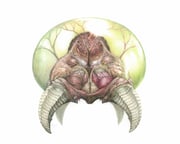
Artist's commentary
Metroid Physiology by ~Kalapusa
Traditional Art / Drawings / Illustration / Conceptual ©2010-2011 ~Kalapusa
This is the final reference illustration, rendered with pencils, to be used for the metroid specimen sculpture. It marks the end of many months of work on designing a reinterpretation of the iconic monster into something that could exist in real life. The following is a summary of the biological workings of my interpretation of a metroid body, which comprises about half of the work that led to this design. Some artistic liberty had to be taken for the transition, so please keep that in mind.
Special thanks to Krystaline Fox and Nicole Bouchard for their help!
Basic Physiology of the Metroid
by Kalapusa
Death by metroid is, by design, as painful as it gets, since its survival depends on overstimulating the nerve systems of live prey in order to detour and absorb the resulting electric current before it consumes the body. The process of consumption can be traced and explained visually, as the rather unique assembly of organs can be seen through its seemingly impenetrable shell.
Once its claws latch onto a victim's head, four electrodes surround a cavity that functions as a mouth/anus combo. These are used to jack into the body's nerve system and trick it into a state of complete pain, so that it may steal the resulting electric charges. The victim basically is electrocuted by charges produced in its own body while the metroid gathers as much as it can before the host dies. Once the victim perishes, the metroid is unable to exploit its chemistry any longer and then proceeds to consume the flesh of the cooked brain, leaving the rest of the body for later consumption as needed.
Right above its oral cavity is the equivalent of a crop, where food is broken down further before being sent to be digested and processed in four separate stomachs, each with their own specialty. Most of this is used to support cell regeneration, but it manages to convert some of the material into electricity by sending it to one of four organs, each right above the claw muscles. Energy collected directly from prey or by digestion is sent from here to be stored in the uppermost organ, which also carries minimal brain functions. Its thought capability is a subject of ongoing debate, most believing that despite the size, complexity and high energy of the brain, it is driven merely by the attraction to more energy.
The end result is a collection of energy substantial enough to use as a form of defense without fear of depletion. Electricity permeates throughout the metroid's body, keeping it harmful to the touch, but its main defense is through a direct expulsion of powerful charges through four veiny stems. When the electric mediums are in play, it may reacquire static electricity in its proximity by absorbing it back into a pair of organs at the mediums base, before being sent back to the main energy storage. Although it survives upon the surplus of consumption, the metroid can overdo it and must periodically release excess energy. Its effectiveness in collecting it makes it dangerously sought after as an energy source, despite its reputation as a major ecological threat.

